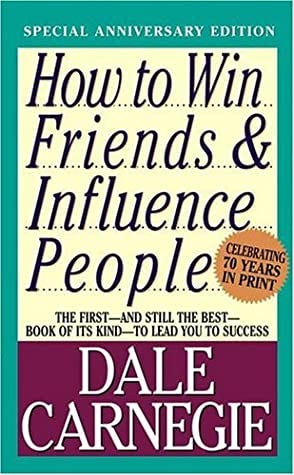How to win friends and influence people 📖
Read to know the summary of this book which was written by Dale Carnegie in 1936
Before Proceeding, one thing:
TelEmpathy is a platform for your Daily Mental Health Care
Download our android app
This book has surely shaped behavioral psychology into the way we know it today, as it reads like an instruction manual on how you can be more liked by others, get them to do favors for you, and even change their behavior under your influence.
However, none of it is based on manipulation and deceit. Dale Carnegie does it all based on the core idea that you can change other people’s behavior simply by changing your own.
Here are 3 valuable lessons from How To Win Friends And Influence People:
You can make a great first impression just by smiling.
To be interesting to others, talk about their favorite topic: themselves.
If you want to convince people, get them to say yes a lot.
Lesson 1: A simple smile is all it takes for you to make a great impression.
There’s that famous quote about how actions speak louder than words because in the way we act we truly show whether we follow through on our intentions, instead of just stating them.
The easiest action you can take to make others instantly like you then, is to smile.
Just like we all tear up when a baby laughs or smiles at us, or feel a rush of endorphins from seeing a dog wag its tail in our presence, we can’t help but feel affection towards someone who smiles at us.
Now imagine a smile being the first thing you see the first time you meet someone and shake their hand – of course, you’re going to like them!
More than half of our communication is based on body language, so a smile vs. a frown can make the difference between making a new friend or selling a car and striking out.
What’s more, smiling isn’t a one-way road, it helps you directly too.
By consciously smiling you’ll generate positive feelings “by accident”, just like positive feelings can cause you to smile without meaning to.
So the next time you meet someone new, turn that frown upside down and smile as you shake their hand!
Lesson 2: You can be interesting to others by getting them to talk about themselves.
What’s everyone’s favorite topic? The weather? Nope. Themselves!
We all love people who listen to us for hours end as we yatter on and on about our own lives.
People always think to be interesting you have to share many fascinating stories and constantly talk about your accomplishments.
That couldn’t be more wrong. You don’t even have to talk to be interesting.
Humans are naturally self-centered, we are our own biggest interests, and boy do we get excited if we meet someone who shares that interest!
Give other people your full attention, don’t interrupt them, be genuinely interested, ask follow-up questions, don’t rant about yourself, and, most importantly, listen.
You’ll be amazed at how many people will say things like this about you: “That Nik guy was so great to talk to, what an interesting person!”
If you want to go one step further, you can do what Teddy Roosevelt did, and even prepare yourself before you meet someone by researching them online and trying to pick 2-3 of their favorite topics, which you can then address and get them to talk about.
Lesson 3: In order to convince people, you have to get them to say yes a lot.
Dale Carnegie has 3 steps to help you convince people, the premise of all of them being that they don’t know you’re trying to change their minds.
We hardly defend anything as strongly as our own opinions, so the second we’re on to someone trying to win us over, it’s a hopeless cause.
Unless you’ve spilled the milk already, here are 3 steps to help you succeed:
Be nice. Do the above. Smile. Listen. Be polite and patient, that’s the basis of any successful persuasion and for that matter, should be the basis of any conversation.
Make it clear you have the same goals. Your conversation partner must believe you share the same interests and vision, so emphasize that by talking about the interests you actually share. They have to know you’re really on their side and want what’s best for them (which you hopefully are anyway).
Ask them lots of small questions that they answer with yes. Once you’re sure you’re both on the same page, you can start laying out your arguments, but do it by asking questions your partner can answer with yes as much as possible. Then, when you make your final point, you’re more likely to get a yes as well.
The idea behind this approach, called the Socratic method, is that the probability of a final yes goes up with every yes you get before. This is due to the human consistency bias – we want to be consistent in our actions, so we’re unlikely to break a long chain of yeses.
Share this article on WhatsApp & LinkedIn
Liked the content? Give us a Like ❤️️ & Comment your views
Have a great week ahead😄



